QUALITY SEED PRODUCTION IN SORGHUM VARIETIES
Land requirements
- Land selected for sorghum seed production should have good drainage facility so as to avoid water stagnation.
- Previous crop in the land should not be of any other variety of sorghum.
- If it is of other variety or same variety of sorghum crop growth during the previous season the seeds that might have fallen form the previous crop should be allowed to germinate after irrigating the land.
- The germinated seedlings should be destroyed by ploughing.
|
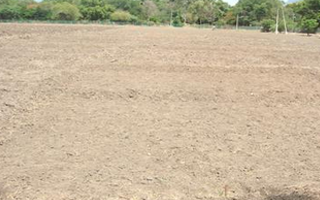 |
| Isolation distance |
- Sorghum is an often crops pollinated crop having 50% cross pollination. Isolation distance should be maintained so as to avoid varietal contamination of seed.
- Isolation distance is the distance by which the seed crop is separated from any other variety of the same crop.
| Contaminants |
Isolation Distance (M) (Minimum) |
| |
Foundation seed |
Certified seed |
| Other varieties |
200 |
100 |
| Sudan grass |
400 |
400 |
| Fodder sorghum and tillering varieties |
400 |
400 |
Optimum season
- Seed crop should be grown in appropriate season because seasonal difference will affect the quality of the seed
- Though sorghum is grown as rainfed as well as irrigated crop in different seasons, appropriate season to produce good quality seeds is important.
- For quality seed production, dry and cool weather is more favourable than hot and humid weather during panicle emergence and seed development stage.
- Rains during seed maturation may cause seed discolouration and ergot disease.
- For seed production, sowing may be done during June – July and October – November seasons. Of these, October - November is more conductive for quality seed production.
|
Seed selection
- Good quality seeds should be used to maintain the required crop stand. Germination potential of the seed should be tested before sowing, because crop performance and yield and decided by the crop stand
- All the expenditure incurred on the crop will be a waste, if the stand is poor. Hence, it is better to know the germination level in the seed sample before taking up sowing.
- Seeds with low germination will also be less vigorous and hence crop growth is very much reduced. Seeds affected by sugary diseases should be removed.
For sowing one hectare of land, 10 kg of seed is required. For certified seed production, foundation seed should be sown. |
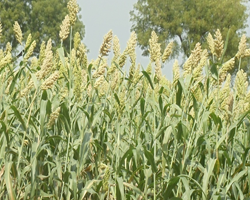 |
Seed hardening
- Seed hardening is a process or treatment by which plants growing from the hardened seeds are capable of withstanding soil moisture stress
- Seeds are soaked in 2% potassium dihydrogen phosphate solution for 10 hrs and then dried back to original moisture
- Instead of chemicals, botanicals like Prosopis juliflora leaf extract (1%) can also be used for hardening purpose.
- One kg of seeds are to be soaked in 600 ml of leaf extract for 16 hours. Hardened seeds will have the ability to withstand drought during germination and plant growth.
|
 |
| Attention |
- While hardening, seeds should be dried back to original moisture after
Field preparation and seed sowing
- After the application of 12.5 tonnes of FYM, plough the field 2 to 3 times. Then apply 2 kg of Azospirillum uniformly.
Formation of ridges and furrows
- After the basal application of above fertilizers, ridges of six metre length are formed at 45 cm distance. Seeds are sown with a spacing of 15 cm on one side of the ridge
Fertilizer application
- After furrow formation, fertilizer should be applied uniformly in the furrow.
Fertilizer application
- After furrow formation, fertilizer should be applied uniformly in the furrow.
Fertilization
| Fertilizer (kg/ha) |
Nitrogen |
Phosphorus |
Potash |
| Basal application |
50 |
50 |
50 |
| 25 days after sowing |
25 |
|
|
| 45 days after sowing |
25 |
|
|
Micronutrient
- We know how important the fruits and vegetables are for the diet of human beings. Similarly in addition to NPK fertilizers, micronutrients are also to be applied to the seed crops
- For zinc deficient and iron deficient soils, 25 kg of ZnSO4 and 50 kg of FeSO4 have to be applied respectively.
|
| Irrigation Management |
- According to the soil condition, irrigation is given once in 7 days or once in 10 days. The following are the important stages in which drought should be avoided.
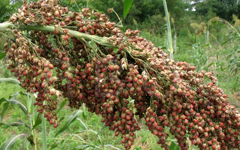
1.Panicle emergence stage |
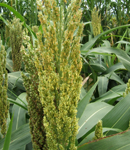
2.Flowering stage |
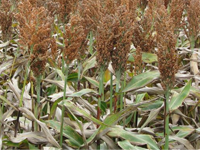
3.Seed maturation stage |
|
| Weed Control |
- From early stage onwards, sorghum field should be kept weed free. For control of weeds, 500 g of Atrazine has to be sprayed on the soil surface dissolved in 100 litre of water, three days after sowing
- One additional hand weeding should be given 30 to 35 days after sowing.
Plant protection
- For quality seed production, seed crop should be protected from pest and diseases. So recommended control measures for pest and diseases should be followed.
Importance of removal of off types in quality seed production
- In order to maintain the genetic purity, seed crop should be isolated from other sorghum crops of other varieties. In some sorghum fields some plants are either taller or shorter than rest of the population
- Differences may also occur in shape and colour of the leaves, shape of panicle, glume colour and flowering time. Plants showing such deviant features as compared to varietal characters are called offtypes or rogue.
- he operations involving the removal of off-types is called as rouging. If the offtype plant pollinates the normal plants, the genetic purity of the resultant seed will be affected. Rouging operation at the following stage is to be carried out.
|
What is offtypes?
- Plant or seed deviating significantly from the characteristics of a variety as described by the breeder in any observed respect
|
 |
Rogue plants in sorghum
| Growth stages |
Off-types |
| Before flowering |
Self sown crop plants with different leaf colour, shape and stem colour |
| During flowering |
Early or late flowering plants and plants with deviant panicle shape |
| Before harvest |
Panicle affects by ergot, fungi and smut and plants with deviating panicle features |
|
| Harvesting and threshing |
Appropriate stage for harvest
- Harvesting should be done at appropriate stage. Sorghum crop should be harvested from 40-45 days after 50% flowering. At this stage, moisture content will be around 20-22 per cent, seeds will have black layer at the basal portion.
- Seed weight, germination and vigour would also be high. The seeds harvested before harvestable maturity are immature and will shrink upon drying. Delayed harvest results in lowering of seed yield and quality due to shattering loss, damage due to insects and birds and seed blackening caused by pathogenic infections.
|
 |
| Seed yield |
- Seed yield of 2000 kg ha-1 can be harvested.
Seed quality maintenance
- After the harvest, threshing and quality upgradation should be carried out.
Earhead threshing and drying
- The harvested earheads should be dried to bring down the seed moisture content to 15-18 per cent. If the seed moisture is below 15% then, seed injury may occur due to cracking and if the moisture content is above 18% then there will be chance for occurrence of crushing injuries.
- These mechanical injuries may affect the germination and vigour of the seed besides paying way for fungal infection.
Drying
- Harvested seeds have to be dried immediately, otherwise, because of internal heating, germination will be reduced when moisture content is high. Seeds are to be dried to a moisture content of 10-12 per cent.
Seed Processing
- Seed processing is an operation by which all immature, wrinkled, broken and small seeds as well as all physical impurities such as sand, stones, dust, other crop sees and week seeds are removed. For processing sorghum seeds, sieve of 9/64" diameter can be used so as to get uniform size seeds.
Attention
- Seed crop should not be treated as grain crop. Processing machine should be thoroughly cleaned before processing in order to avoid physical contamination.
Safe seed storage methods
- Processed seeds should be protected and stored so as to maintain the seed quality upto the next sowing season.
Seed moisture content
- If seed moisture is more, the germination ability of the seed will decrease. For storage of one year, the seeds have to be dried to 12 per cent and longer storage period it has to be dried below 8% moisture content and stored in moisture vapour poof containers.
Seed treatment
- Seeds dried to safe level of moisture should be treated with captan 75% WP @ 70 gm in 500 ml water for 100 kg of seeds. After seed treatment, the seed can be stored for one year in cloth bags and if the seeds need to be stored beyond one year, they should be dried to 8% moisture, treated and then stored in moisture vapour proof container like 700 guage polythene bag.
- These seeds could be stored upto 1 ½ years. Instead of poisonous chemicals, use a safe and non-poisonous chemicals like Halogen mixture is recommended for treating sorghum seeds @ 3 g kg-1 of seeds.
- Halogen mixture can be prepared by mixing bleaching power (calcium oxy chloride) + calcium carbonate + arappu leaf powder (Albizzia amara) 5:4:1 proportion respectively and then storing in moisture vapour poof container for a week before use.
|
| Storage methods |
- Always, new bags have to be used for packing the seeds. Seeds are hygoroscopic in nature which means they have the tendency to absorb moisture from the atmosphere.
- In sea shore and deltoic areas where relative humidity of the atmosphere is normally more, seeds stored in cloth or gunny bags, loose viability fast. In such places, moisture vapour proof containers like polythene (700 guage thickness) bags can be used.
|
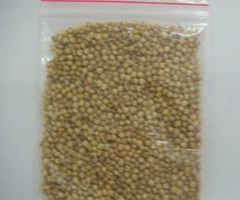
|
| Sorghum seed packed in 700 polybag |
Attention
- Seed Moisture should be lowered below 8%, when the seeds are stored in moisture vapour poof container. Otherwise they will deteriorate much faster.
- Direct contact of seed bags with the floor or wall is to be avoided. Seed bags should be stacked above the wooden pallet. While stacking, number of bags per row should not exceed 8, otherwise seeds in the lower bag will deteriorate due to pressure.
Storing
- Seed lots have to be stored with separate and clear identity. Storage godown has to be thoroughly cleaned before storing seeds
Seed certification
- Seed certification guarantees the quality of seed as it ensures that the certified seed has the genetic, physical, physiological and seed health qualities. Genetic purity means that the seed gives rise to a plant which conforms to the varietal characteristics of the variety.
- The physical purity means that the seed is free from stones, broken seeds, straw bits and leaf bits etc.
- Physiological quality is measured by germination and seed health envisages freedom from pest and diseases.
- Seed certification is being done in many stages. It starts from verifying whether seeds were obtained from authenticated source, verification of isolation distance and inspection during plant growth, flowering, harvesting, processing and bagging.
- Also seed samples are drawn form the seed lot and sent to seed testing lab to test whether the seeds are possessing required physical purity and germination.
- Then certification tag is issued. Colour of the tag is blue for certified seeds.
- Only those seeds harvested from fields having prescribed field standards and possessing required seed standards are certified by the Certification Agency.
- Seeds thus certified are offered for sales. For further details nearer seed certification office may be contacted.
|
| Field Standards |
| Factor |
Maximum permitted (%) |
| |
Foundation |
Certified |
| Off types |
0.050 |
0.10 |
Designated diseases (Sugary disease and smut)
|
0.050 |
0.10 |
Seed Standards
| Seed standards |
| Factor |
Certified |
| Pure seed (minimum) |
98.0% |
| Inert matter (maximum) |
2.0% |
| Other crop seeds (maximum) |
10 / kg |
| Weed seeds (maximum) |
10 / kg |
| Other distinguishable varieties (maximum) |
20 / kg |
| Diseased seed (maximum) |
0.04% (by number) |
| Germination (minimum) |
75% |
| Moisture (maximum) |
- |
| For moisture pervious containers |
12% |
| For vapour proof containers |
8% |
|
| QUALITY SEED PRODUCTION IN SORGHUM HYBRIDS |
Parental lines for some of the hybrids
| Hybrids |
Female line |
Male line |
| 1.CSH – 5 |
2077 – A |
CS – 3541 |
| 2. CSH – 9 |
296 - A |
CS – 3541 |
| 3.Kovilpatti tall |
2219 – A |
IS – 3541 |
| 4.Kovilpatti tal |
2077 – A |
699 Tall |
| 5.CSH – 15 R |
104 – A |
R – 585 |
| 6. 296 – A |
296 – A |
TS – 30 |
- In sorghum hybrid seed production, cytoplasmic genic male sterility system is employed. Here, the female plants are male sterile and called as 'A' line plants.
- The male plants are called at 'R' line or Restore line since it restores the male fertility in the F1 hybrid.
- In order to maintain the ‘A’ line plants, they are crossed with 'B' line or maintainer line plants. 'B' line plants are fertile counterparts of ‘A’ line plants.
- They are isogenic to 'A' line plants in all features except male sterility
Selecting the right season
- In sorghum hybrid seed production, cytoplasmic genic male sterility system is employed. Here, the female plants are male sterile and called as 'A' line plants.
- The male plants are called at 'R' line or Restore line since it restores the male fertility in the F1 hybrid.
- In order to maintain the ‘A’ line plants, they are crossed with 'B' line or maintainer line plants. 'B' line plants are fertile counterparts of ‘A’ line plants.
- They are isogenic to 'A' line plants in all features except male sterility
Seed rate
- Female parental line – 7.5 kg ha-1
- Male parental lines – 5 kg ha-1
Pre-sowing seed treatment
- Hybrid sorghum seeds can also be produced under rainfed condition. For that, seeds should be infused with drought resistance by giving seed hardening treatment.
Seed hardening
- Soak the seeds in 2% potassium dihydrogen phosphate for 10 hours and then dry the seeds to the original moisture content.
- Alternately, botanicals like Prosopis juliflora can also be used for seed hardening purpose
- Botanicals are also eco friendly. In this method, seeds are soaked in 1% Prosopis leaf extract at seed to solution ratio of 1:0:6 for 16 hours
- Then the seeds are dreid to original moisture content. Dried seed scan be pelleted with dried pungam leaf powder @ 500 gm per kg of seeds
- To facilitate the leaf powder to stick on the seeds, 10% maida solution can be used as adhesive. The plants arising from hardened seeds will withstand drought condition, if any, during the crop growth period.
Isolation distance
- Hybrid sorghum seeds can also be produced under rainfed condition. For that, seeds should be infused with drought resistance by giving seed hardening treatment.
Spacing
- Before sowing, ridges and furrows with a spacing of 45 cm between the furrows are formed.
- Sow the seeds at 1/3 height of the ridge form bottom with a plant to plant spacing of 15 cm. Four numbers of border rows should be sown with male line seeds all around the seed production field.
- Then, female and male line seeds are to be sown with a ratio of 5:2 which means that five rows of female line should be alternated with two rows of male. This is called planting ratio.
Border rows
- During hybrid seed production, four rows of male parental lines are to be grown all around the field. They are called as border rows. The border rows will provide pollen grains to the female plants.
Fertilizer application
- Fertilizers at the rate of 100:50:50 kg Nitrogen, Phosphorus and Potash are to be applied per ha. Of this, 50:50:50 kg of NPK is applied as basal. First top dressing with 29 kg of N is to be applied after first weeding. Second dose of 25 kg N can be given 45 days after sowing.
Micronutrient deficiency
If micronutrient deficiency occurs, not only the seed yield is reduced but also the seed quality will be affected.
- Zinc sulphate at 25 kg per ha may be applied to the zinc deficient soils.
- For iron deficiency, 50 kg of ferrous sulphate with 12.5 tonnes of farm yard manure is to be applied to the soil.
- During plant growth stags, intervenal chlorosis may occur due to iron deficiency. For that, 0.5% ferrous sulphate should be applied as foliar spray.
Roguing
- Roguing operation involves the removal of offtype plants from the seed field.
- To maintain genetic purity, offtypes should be removed before flowering stage.
- In a hybrid seed crop, it is important to carry out rouging both in male and female rows.
- Besides this, some of the pollen shedding plants called as pollen shedders should also be removed from the female rows.
- Farm women will attend the rouging operations in an effective way.
What is offtypes?
- Plant or seed deviating significantly from the characteristics of a variety as described by the breeder in any observed respect.
Attention
- Pollen shedders have to be removed and carried away from the early stages.
- For weed control, 200 gm Atrazine dissolved in 1000 litre of water for one ha can be sprayed.
- After 30-35 days, hand weeding is necessary.
|
| Synchronisation of flowering |
- In sorghum hybrid seed production, the female line used is male sterile. For fertilizing the flowers of the female line, pollen has to come from the male plants.
- If only the flowering in the female line coincides with the flowering in the male line, proper pollination and seed set in the female are possible.
- Simultaneous flowering in both female and male plants is called as synchronization of flowering.
|
 |
| Panicle initiation in Sorghum |
Methods to achieve synchronisation
Best method to achieve synchronisation is to stagger the sowing of parental lines based on previous knowledge about the duration of flowering. Late parent should be sown early and early parent late. In spite of this precaution, if a gap in flowering period is predicted based on panicle initiation, then the following methods can be followed to hasten the late parent or delay the early parent by 2 or 3 days
- The advancing parent has to be sprayed with 500 mg malic hydrazide in one litre of water, 45 days after sowing. Maleic hydrazide will not dissolve in water, you have to dissolve it in a little volume of sodium hydroxide and then make up the volume with required quantity of water.
- 1% urea solution has to be sprayed on the late parent.
- One irrigation may be skipped for the advancing parent.
- Flowering can be delayed, by spraying CCC (Chloro choline chloride) at a concentration of 300 ppm.
Attention
- High yield of hybrid seed can be obtained only when proper synchronization of flowering occurs between the female and male plants.
Stage of harvest
- Harvest the crop 40-45 days after 50% flowering. At that time, seed moisture would be around 25-30 per cent. A black layer will be visible at the base of the seed is the visible symptom of seed maturity.
Harvesting
- First, the male rows including the border rows are to be harvested and the earheads removed from the field. Then, harvest the female rows. Seeds harvested from the female rows are the hybrid seeds.
Seed yield
Threshing
- Seeds can be threshed either by manual method or by using mechanical threshers. During threshing, if seed moisture is kept at 15-18%, mechanical injury to the seed will be less.
Seed drying
- Seed can be dried either under sun or by using mechanical driers. If you dry the seeds under sun, avoid the noon hot sun. During the noon time, temperature will be very high and exposing the seeds to such high temperature will affect viability. If mechanical drier is used, ensure that the drying temperature does not exceed 40°C.
Seed Processing
- Process the seeds with 9/64" round perforated sieve for size grading.
|
| Seed storage methods |
- Before seed storage, seed has to be dried to 12% moisture content. Seed treatment with Thiram or Captan 75% wp at the rate of 70 gm in 500 ml of water per 100 kg seeds is necessary.
- After this treatment, seeds can be stored for more than one year. Seeds dried to 8% moisture content can be stored upto one and half years in moisture vapour poof containers like polythene bags.
|
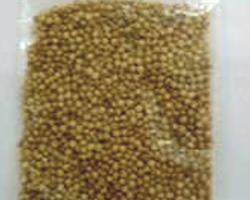 |
| Seed certification |
- Seed certification guarantees the quality of seed as it ensures that the certified seed has the genetic, physical, physiological and seed health qualities. Genetic purity means that the seed gives rise to a plant which conforms to the varietal characteristics of the variety.
- The physical purity means that the seed is free from stones, broken seeds, straw bits and leaf bits etc. Physiological quality is measured by germination and seed health envisages freedom from pest and diseases.
- Seed certification is being done in many stages. It starts from verifying whether seeds were obtained from authenticated source, verification of isolation distance and inspection during plant growth, flowering, harvesting, processing and bagging.
- Also seed samples are drawn form the seed lot and sent to seed testing lab to test whether the seeds are possessing required physical purity and germination.
- Then certification tag is issued. Colour of the tag is blue for certified seeds.
- Only those seeds harvested from fields having prescribed field standards and possessing required seed standards are certified by the Certification Agency. Seeds thus certified are offered for sales.
- For further details nearer seed certification office may be contacted.
Field standards (Certified seed)
| Factor |
Maximum permitted % |
| 1. Off types (%) (maximum) |
0.10 |
| 2. Pollen shedders (%) (maximum) |
0.10 |
| 3. Ergot affected plants (maximum) |
0.10 |
Seed standards (Certified seed)
| Factor |
Standard |
| 1. Physical purity (%) minimum |
98.0 |
| 2. Inert matter (%) maximum |
2.0 |
| 3. Others crop seeds (maximum) |
10 Nos/Kg |
| 4. Weed seeds (maximum) |
|
| 5. ODV (maximum) |
|
| 6. Germination (%) (minimum) |
|
| 7. Seed Moisture (%) (maximum) |
|
| Moisture pervious container |
|
| Moisture impervious container |
|
|
|

